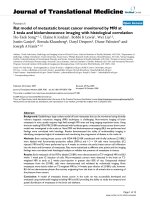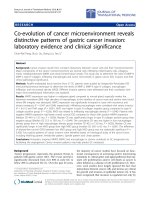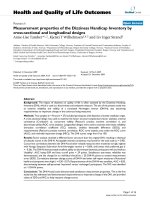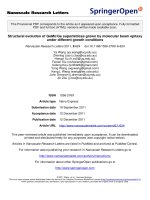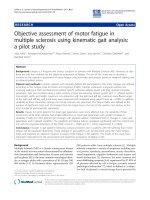Báo cáo hóa học: " Size Evolution of Ordered SiGe Islands Grown by Surface Thermal Diffusion on Pit-Patterned Si(100) Surface" doc
Bạn đang xem bản rút gọn của tài liệu. Xem và tải ngay bản đầy đủ của tài liệu tại đây (363.5 KB, 5 trang )
SPECIAL ISSUE ARTICLE
Size Evolution of Ordered SiGe Islands Grown by Surface
Thermal Diffusion on Pit-Patterned Si(100) Surface
Giovanni Maria Vanacore
•
Maurizio Zani
•
Monica Bollani
•
Davide Colombo
•
Giovanni Isella
•
Johann Osmond
•
Roman Sordan
•
Alberto Tagliaferri
Received: 2 July 2010 / Accepted: 9 September 2010 / Published online: 30 September 2010
Ó The Author(s) 2010. This article is published with open access at Springerlink.com
Abstract The ordered growth of self-assembled SiGe
islands by surface thermal diffusion in ultra high vacuum
from a lithographically etched Ge stripe on pit-patterned
Si(100) surface has been experimentally investigated. The
total surface coverage of Ge strongly depends on the dis-
tance from the source stripe, as quantitatively verified by
Scanning Auger Microscopy. The size distribution of the
islands as a function of the Ge coverage has been studied
by coupling atomic force microscopy scans with Auger
spectro-microscopy data. Our observations are consistent
with a physical scenario where island positioning is
essentially driven by energetic factors, which predominate
with respect to the local kinetics of diffusion, and the
growth evolution mainly depends on the local density of
Ge atoms.
Keywords SiGe islands Á Ordering Á Pit-patterned Si
surface Á Nucleation Á Diffusion Á Growth dynamics
Introduction
Stranski–Krastanov (SK) growth of SiGe islands on
Si(100) substrates has become a model system for nucle-
ation [1], faceting [2, 3] and intermixing [4, 5]. For many
technological applications [6], which require the individual
addressability of the islands, the randomness in their
positioning on a flat substrate impose serious limitations.
Substrate two-dimensional patterning has been shown to
induce an ordered growth process with a controlled posi-
tioning [7]. Usually, the templates consist of a 2D array of
pits where only a single island develops at the pit bottom
[8]. In order to further explore device engineering in these
systems, some crucial parameters must be controlled. From
a mesoscopic point of view, island shape and size distri-
butions are the most important factors that can be managed.
Hence, it is imperative to understand and control the
growth conditions for a rational nanostructures design.
In this work, we investigate the self-assembly of SiGe
islands on a pit-patterned Si(100) surface grown by a novel
method, which makes use of a lithographically etched Ge
stripe used as atomic source directly placed on the sample
surface. The total surface coverage of Ge strongly depends
on the distance from the source stripe, so that the method
allows to investigate the island growth over a wide range of
dynamical regimes at the same time. A similar approach,
using an artificially induced gradient of the Ge coverage,
has been recently employed by Brehm et al. [9] for the
study of the SK growth onset in case of flat surface. From
the size evolution exhibited by the ordered nucleated
islands as a function of the distance from the source stripe,
we propose a scenario where island positioning is essen-
tially driven by energetic factors, which predominate with
respect to the local kinetics of diffusion, and the growth
evolution mainly depends on the local density of Ge atoms.
G. M. Vanacore (&) Á M. Zani Á A. Tagliaferri
CNISM and Dipartimento di Fisica, Politecnico di Milano,
Piazza Leonardo da Vinci 32, 20133 Milano, Italy
e-mail:
M. Bollani
CNR-Istituto di Fotonica e Nanotecnologie, via Anzani 42,
22100 Como, Italy
D. Colombo Á G. Isella Á J. Osmond Á R. Sordan
CNISM and LNESS, Dipartimento di Fisica, Politecnico di
Milano (Polo Regionale di Como), Via Anzani 42, 22100 Como,
Italy
J. Osmond
Institute of Photonics Sciences, 08860 Barcelona, Spain
123
Nanoscale Res Lett (2010) 5:1921–1925
DOI 10.1007/s11671-010-9781-0
Experiment and Methods
The samples consist of Ge stripes (width * 375 lm)
obtained by a photolithographic patterning of pure Ge thin
films (thickness * 50 nm), grown on a Si(100) substrate
by Low Energy Plasma Enhanced Chemical Vapour
Deposition (LEPECVD) [10]. The sample surface close to
the stripe region has been patterned with a squared two-
dimensional array of circular pits (diameter * 150 nm,
depth * 25 nm, period * 1 lm) with an overall width of
about 10 lm from the stripe edge, obtained by means of
Electron Beam Lithography (EBL) and reactive Ion Etch-
ing (RIE). Removal of native silicon oxide and germanium
oxide has been obtained by using a diluted HF solution at
10% for 30 s at room temperature. Surface contaminations
have been removed by in situ low-temperature outgassing
(T B 500°C) and a mild Ar
?
ion sputtering. A PHI 660
Scanning Auger Microscope (SAM) has been used for in
situ Scanning Electron Microscopy (SEM) and spatially
resolved chemical characterization at the sample surface
before and after thermal diffusion. The stripes act as Ge
sources directly placed on the sample surface, and self-
assembled SiGe islands spontaneously originate along a
continuous diffusion profile after annealing at high tem-
peratures in UHV. The samples have been annealed by
direct Joule heating running a DC current through the Si
substrate. The temperature stabilization takes less than
30 s, and the temperature spatial distribution is highly
uniform in the investigated area. The base pressure during
the annealing time was always better than 1 9 10
-9
torr.
Atomic Force Microscopy (AFM) for ex situ analysis of the
nucleated islands has been performed using a Veeco
Innova microscope operated in tapping mode with ultra-
sharp tips (nominal tip radius about 2 nm). Statistical
analysis of AFM data has been performed using freely
available software tools [11].
Results and Discussion
During the annealing process, the Ge diffusing from the
stripe on the Si surface forms a continuous over-layer (OL).
Figure 1a shows the SEM micrograph of the stripe in a
region of the sample without pit patterning before (upper
inset) and after (main panel) a 7.5-min annealing at 625°C.
The shading at the sides of the stripe results from the
compositional contrast of the secondary electron emission
between Ge, diffused on the surface, and Si in the substrate.
The thickness and composition of the diffused over-layer,
shown in Fig. 1b, have been obtained by monitoring the Ge
LMM and Si LMM Auger lines measured as a function of
x and fitting their intensities with a discrete layer model
[12] where the OL is approximated by a Si
1-a
Ge
a
thin film
of variable thickness along the x-direction and uniform
composition a along its depth [13]. Since the size of the
electron beam of our Scanning Auger Microscope is con-
siderably smaller than the distance between the islands and
with respect to the length scale over which the thickness
and composition vary significantly, we could assume a
uniform layer in the probed region, and thus, the Auger
spectro-microscopy analysis performed in situ after the
annealing allowed the determination of the thickness and
composition of the wetting layer between the islands as a
function of x.
A gradient into the Ge coverage has been thus induced
by the diffusion process, strongly modulating the local
density of Ge atoms upon the distance from the source
stripe. For annealing at 625°C, we found an average Ge
Fig. 1 (Color online). a Scanning electron micrograph of the stripe
in a region of the sample without pit patterning before (upper inset)
and after (main panel) a 7.5-min annealing at 625°C. The lighter part
at the center of the image is the Ge stripe. The shading at the sides of
the stripe results from the compositional contrast of the secondary
electron emission between Ge, diffused on the surface, and Si in the
substrate. b Thickness (filled black squares) and composition (open
blue circles) of the diffused over-layer upon the distance, x, from the
stripe edge, as obtained by monitoring the Ge LMM and Si LMM
Auger lines and fitting their intensities with a discrete layer model
(see text)
1922 Nanoscale Res Lett (2010) 5:1921–1925
123
relative concentration of about 0.73 ± 0.03, in good
agreement with the values found in literature for the case
of MBE deposition [14]. Spontaneous nucleation of self-
assembled SiGe islands coexists with the continuous
surface diffusion of Ge. Figure 2a–b and c–d show repre-
sentative SEM and AFM images, respectively, of the
sample surface in the pit-patterned region after annealing at
625°C for 7.5 min. Islands are essentially dome shaped and
preferentially develop at the pit positions creating an
ordered squared 2D array following the pit pattern: only
*10% of islands nucleated within the textured region are
outside of the pit positions, and only * 7% of pits are
empty or partially filled. The ordered island growth has
been obtained by controlling the local atomic mobility by
purposely choosing the growth parameters (annealing time
and temperature). This allowed to make the diffusion
pathway run by each atom before the formation of a critical
nucleus longer than the step size of the pit pattern and thus
to favor the island formation at pit positions, which rep-
resent preferential nucleation sites since a total elastic
energy minimum is reached at the pit bottom [8].
Figure 3a shows the volume of individual ordered
grown islands nucleated in the pit-patterning region,
derived by AFM data, as a function of the distance, x, from
the stripe. For the estimation of the island volume, we
considered only the portion of the dome above the sur-
rounding 2D flat surface; the contribution of Ge volume
inside the pit underneath the island is negligible and has not
been taken into account. Indeed, our conclusions about the
factors governing the growth process will be not affected
by this evaluation. Larger islands preferentially nucleate
close to the stripe, while small islands grow farther away
from it (see Fig. 3a), showing a continuous variation
greater than one order of magnitude in their volume. In this
case of ordered growth, the areal density of the nucleated
islands and their positioning are essentially driven by the
elastic energy minimization on a textured surface, which
predominate with respect to the local kinetics of diffusion
of Si and Ge atoms. We propose that this size evolution is
mainly due to the gradient into the Ge coverage induced by
the long-scale diffusing motion of Ge atoms from the
stripe. In fact, regions farther away from the stripe exhibit a
lower local density of Ge atoms and thus a smaller amount
of Ge available for a growing island. A lower average Ge
content could be thus responsible for a smaller island size,
as experimentally demonstrated by Rastelli et al. [15]in
case of randomly nucleated islands grown by Molecular
Beam Epitaxy (MBE). However, in case of island growth
by Ge surface diffusion over a flat Si(100) surface without
any pit patterning, we observed that the region with highest
Ge coverage (close to the stripe) presents the lowest
average island sizes, while where the coverage decreases to
about 4 ML (farther away from the stripe), the biggest
average dimensions of the islands are attained (see Fig. 3b,
showing the case of annealing at 600°C). Therefore, the
artificial pit patterning used in combination with the self-
assembled growth by surface thermal diffusion allows to
modulate the Ge coverage keeping at the same time fixed
the island density and the capture zone area, from where
islands gather mass to grow. This effectively separates the
factors governing the formation of the critical nuclei from
the following growth process of the islands determining
their final size. Contrarily, in case of random nucleation,
kinetic factors influence both the nucleation mechanism
and the growth process, strongly modulating the island
density and the capture zone area. Actually, on a flat Si
surface, the island density decreases going far away from
the stripe (not shown), and thus, the capture zone area
increases correspondingly, inducing a progressive increase
in the island volume (Fig. 3b), eventually determined by
the interplay of Ge coverage, capture area and SiGe
intermixing. A more detailed discussion about randomly
nucleated islands is far from the scope of the present paper
and will be reported elsewhere [13, 16].
A quantitative validation of our educated guess about
the factors governing the ordered growth process in pres-
ence of pit patterning can be obtained by correlating the
volume of ordered grown islands with the effective Ge
volume within the OL per island (see Fig. 3c). The last is
obtained by integrating the Ge coverage within the capture
zone of each island. In principle, in case of a perfectly
ordered 2D squared array of islands, the capture zone has
the same area for all islands having a squared shape with a
side equal to the step size of the pit pattern. However,
during data analysis, in order to correctly take into account
even the case of not perfectly ordered growth, the capture
Fig. 2 SEM a–b and AFM c–d images of the sample surface in the
pit-patterned region after annealing at 625°C for 7.5 min. The AFM
image in c is shown in gradient mode
Nanoscale Res Lett (2010) 5:1921–1925 1923
123
zone for each island has been obtained by the Voronoi
tessellation of the island network. A good linear correlation
has been found between the volume of ordered grown
islands and the effective Ge volume within the OL as given
by a Pearson’s coefficient, r, of about 0.83, confirming that
their size evolution as a function of x is mainly driven by
the gradient into the Ge coverage. Thus, as a first
approximation, the growth process could be described
within a capture zone model [17, 18], extended to the case
of variable Ge coverage. According to this model, the
island volume scales linearly with the integral of the Ge
coverage over the capture zone area (instead of the straight
capture zone area as in case of homogeneous coverage
[18]).
We stress that the above-mentioned model do not
exclude SiGe intermixing phenomena during the annealing
process, according to which Si penetrates into the growing
islands. Indeed, the growth process can be still well
described by this scaling behavior considering that islands
are in a chemical equilibrium with the wetting layer.
Furthermore, a detailed observation of Fig. 3c reveals a
non-negligible set of islands at low Ge coverage (far away
from the stripe) that deviate from the above-mentioned
model, presenting higher volumes with respect to the linear
scaling fitting. We speculate that the deviation from this
linear scaling behavior could be due to an enhanced SiGe
intermixing, which become significant in low Ge coverage
regions far away from the stripe. There the timescale of the
growth process is slower with respect to the high coverage
region close to the stripe, leaving enough time to islands to
gather Si from their surroundings. If this hypothesis would
be true, we expect that in islands grown farther away from
the stripe, the alloying offers a path for a partial elastic
strain relaxation increasing the critical size for insertion of
misfit dislocations, as found in the case of random nucle-
ation [19]. Opposite to this, the almost negligible SiGe
intermixing for islands grown close to the stripe due to a
rapid growth process should be accompanied by a plastic
relaxation by misfit dislocations. The experimental verifi-
cation of these hypothesis overcomes the scope of the
present paper, but could motivate a further investigation
into the evolution of Ge composition and strain state of
islands grown by surface thermal diffusion on a pit-
patterned surface, possibly addressed in future by
Micro-Raman Spectroscopy and Transmission Electron
Microscopy.
Conclusions
In conclusion, we have investigated the growth of self-
assembled SiGe islands on a pit-patterned Si(100) surface
by surface thermal diffusion from a lithographically etched
Ge stripe. The ordered island growth has been obtained by
Fig. 3 (Color online). a Volume distribution of individual ordered
grown islands on a pit-patterned Si(100) surface, derived by AFM
scans, as a function of the distance, x, from the stripe. Green
diamonds represent average values. b Volume distribution of
randomly nucleated islands on a flat Si(100) surface without any pit
patterning, as a function of the distance from the stripe in case of
annealing at 600°C. c Scatter plot of the volume of ordered grown
islands as a function of the effective Ge volume within the OL per
island, as obtained by integrating the Ge coverage within the capture
zone of each island. The green curve is the best linear fitting of the
data, and r is the Pearson’s coefficient. The blue square indicates a set
of islands at low Ge coverage, far away from the stripe (see scale on
top for a coarse indication of the distance), that deviate from the
capture zone model, presenting higher volumes with respect to the
linear scaling fitting (see text)
1924 Nanoscale Res Lett (2010) 5:1921–1925
123
controlling the local atomic mobility and the length of the
diffusion pathway of Ge atoms, by means of a correct
choice of the growth parameters (annealing time and
temperature). A controlled size evolution of islands grown
in a ordered squared 2D array has been obtained by con-
trolling the diffusion dynamics of Ge from the source
stripe. This entails a variation of the local density of Ge
atoms upon the distance from the source able to modulate
the average Ge content inside the growing islands and thus
their dimensions.
Open Access This article is distributed under the terms of the
Creative Commons Attribution Noncommercial License which per-
mits any noncommercial use, distribution, and reproduction in any
medium, provided the original author(s) and source are credited.
References
1. Y.W. Mo, D.E. Savage, B.S. Swartzentruber, M.G. Lagally, Phys.
Rev. Lett. 65, 1020 (1990)
2. G. Medeiros-Ribeiro, A.M. Bratkovski, T.I. Kamins, D.A.A.
Ohlberg, R. Stanley Williams, Science 279, 353 (1998)
3. F.M. Ross, R.M. Tromp, M.C. Reuter, Science 286, 1931 (1999)
4. R. Magalhaes-Paniago, G. Medeiros-Ribeiro, A. Malachias, S.
Kycia, T.I. Kamins, R. Stan Williams, Phys. Rev. B 66, 245312
(2002)
5. T.U. Schu
¨
lli, J. Stangl, Z. Zhong, R.T. Lechner, M. Sztucki,
T.H. Metzger, G. Bauer, Phys. Rev. Lett. 90, 066105 (2003)
6. O.G. Schmidt, K. Eberl, IEEE Trans. Electron Devices 48, 1175
(2001)
7. Z. Zhong, O.G. Schmidt, G. Bauer, Appl. Phys. Lett. 87, 133111
(2005)
8. Z. Zhong, W. Schwinger, F. Scha
¨
ffler, G. Bauer, G. Vastola, F.
Montalenti, L. Miglio, Phys. Rev. Lett. 98, 176102 (2007)
9. M. Brehm, F. Montalenti, M. Grydlik, G. Vastola, H. Lichten-
berger, N. Hrauda, M.J. Beck, T. Fromherz, F. Scha
¨
ffler, L.
Miglio, G. Bauer, Phys. Rev. B 80, 205321 (2009)
10. G. Isella, D. Chrastina, B. Ro
¨
ssner, T. Hackbarth, H J. Herzog,
U. Ko
¨
nig, H. von Ka
¨
nel, Solid-State Electron. 48, 1317–1323
(2004)
11. I. Horcas, R. Ferna
´
ndez, J.M. Go
´
mez-Rodrı
´
guez, J. Colchero, J.
Go
´
mez-Herrero, A.M. Baro, Rev. Sci. Instrum. 78, 013705
(2007)
12. C.S. Fadley, Prog. Surf. Sci. 16, 275–388 (1984)
13. G.M. Vanacore, M. Zani, G. Isella, J. Osmond, M. Bollani, A.
Tagliaferri, Phys. Rev. B (to be published)
14. M. Brehm, M. Grydlik, H. Lichtenberger, T. Fromherz, N.
Hrauda, W. Jantsch, F. Scha
¨
ffler, G. Bauer, App. Phys. Lett. 93,
121901 (2008)
15. A. Rastelli, M. Stoffel, A. Malachias, T. Merdzhanova, G.
Katsaros, K. Kern, T.H. Metzger, O.G. Schmidt, Nano Lett 8(5),
1404 (2008)
16. A. Tagliaferri, G.M. Vanacore, M. Zani, E. Bonera, G. Isella, J.
Osmond, M. Bollani, F. Montalenti, G. Capellini, to be submitted
17. P.A. Mulheran, J.A. Blackman, Phys. Rev. B 53, 10261 (1996)
18. S. Pratontep, M. Brinkmann, F. Nu
¨
esch, L. Zuppiroli, Phys. Rev.
B 69, 165201 (2004)
19. G.M. Vanacore, G. Nicotra, M. Zani, M. Bollani, E. Bonera,
G. Capellini, G. Isella, F. Montalenti, J. Osmond, A. Picco, A.
Tagliaferri, to be submitted
Nanoscale Res Lett (2010) 5:1921–1925 1925
123


